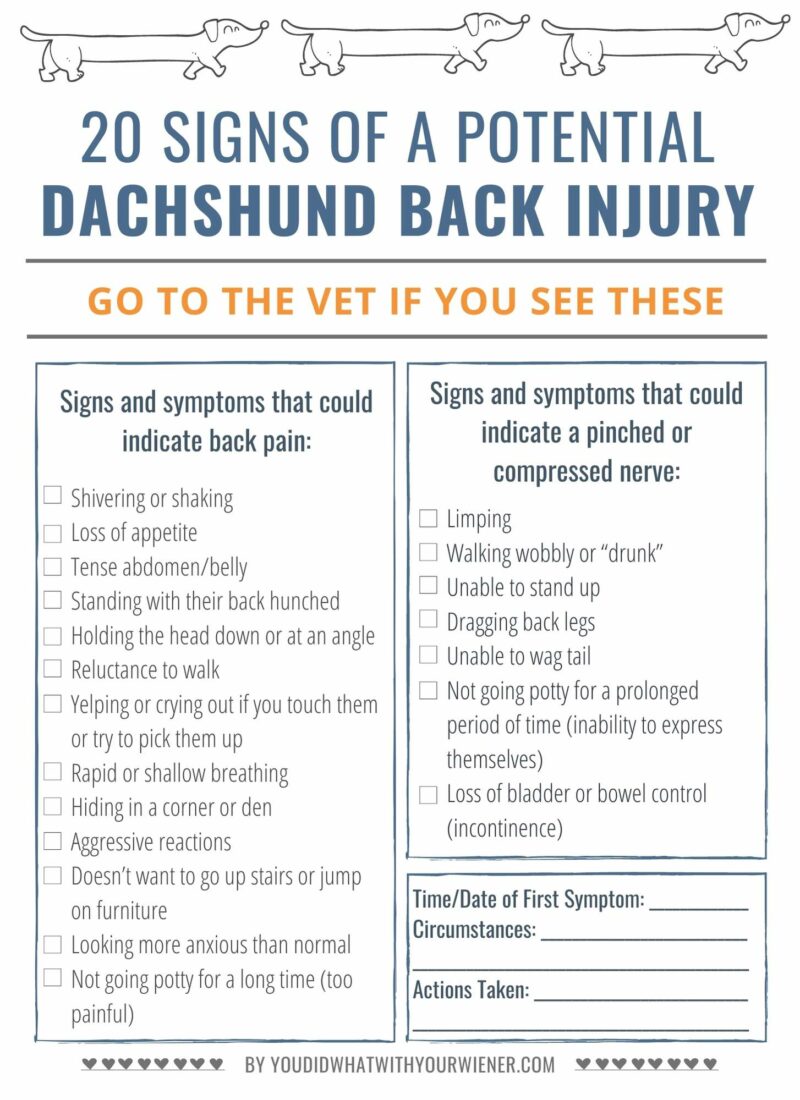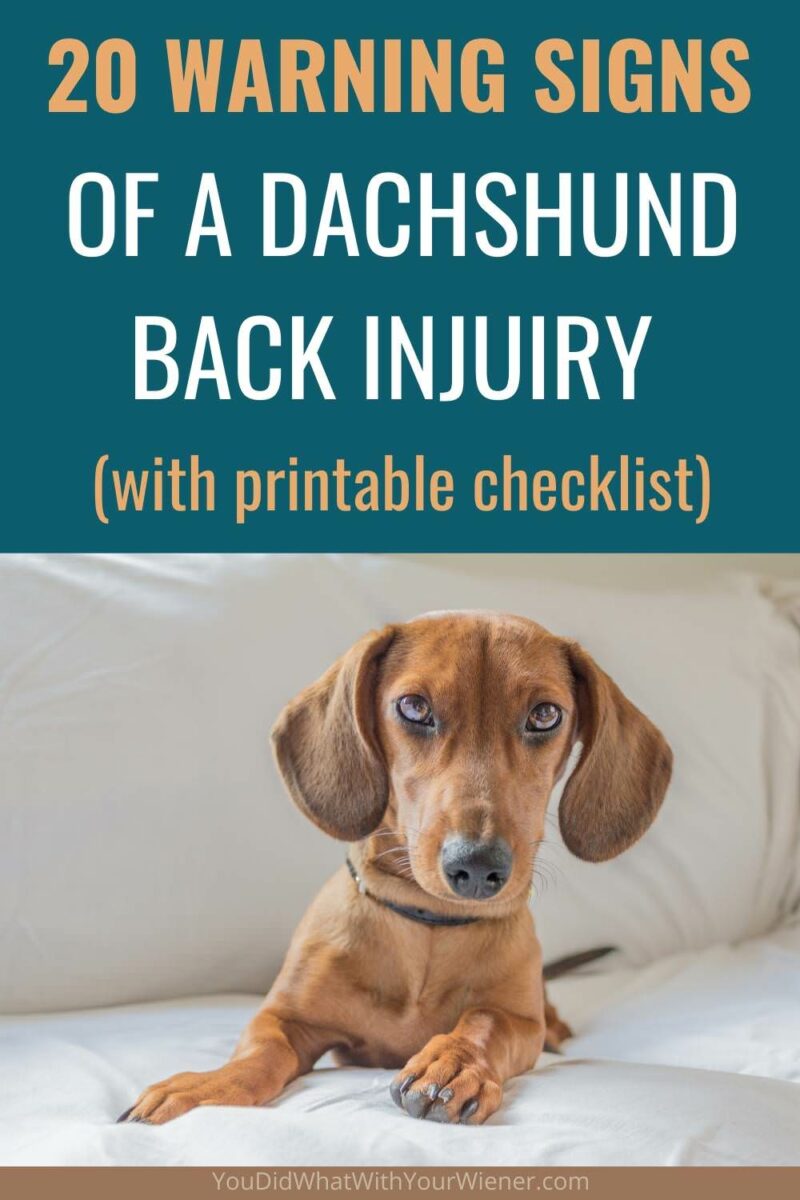20 Warning Signs of a Dachshund Back Injury (With Printable Checklist)
If you have a Dachshund, it’s likely you have heard how common Dachshund back injuries are.
Approximately one in four, or 25%, of Dachshunds will experience a back injury in their lifetime.
Because you won’t be sure your Dachshund has the disease until an injury occurs, the best thing you can do is commit the warning signs of a back injury to memory and get your dog treatment right away if you see them.

To be clear, I am NOT A VETERINARIAN. I can speak from my own experience, knowledge, and stories I’ve heard from others but in no way does my “advice” replace that of a qualified veterinarian.
How a Dachshund Can Injure Their Back
A Dachshund can develop a back injury in one two scenarios – acute injury or from slow disk degeneration.
An example of an acute injury would be a car accident or falling several feet to the ground and would be easily identifiable because you saw a distinct injury occur.
Disk generation – when the spinal disks get brittle and dry over time – happens slowly over time and can’t be seen.
The fragile disks can fully or partially rupture, putting pressure on spinal nerves and causing pain and paralysis.
When this happens in a young Dachshund between 4 and 7 years old, which is most common, the premature aging of the disks is caused by Hansen’s Type I Intervertebral Disc Disease (IVDD).
This genetic disease is related to the gene that creates the Dachshund’s long and low shape – the dwarfism, or chondrodystrophic, gene.
The truth is, if your Dachshund has the gene that caused IVDD, you can’t completely eliminate the chance of your dog suffering a back injury.
In fact, dogs that have the disease will often hurt their backs doing normal things like playing or getting up from their bed.
In other words, there was not a distinct outward cause for the injury.
Always Watch Out For the Signs of a Dachshund Back Injury
I had studied the IVDD disease for years, and was keenly aware of the signs and symptoms of a Dachshund back injury, by the time it happened to my dog.
The minute myy miniature Dachshund Gretel started acting “off”, I rushed her to the emergency vet.
Gretel had the mildest form of injury that can be detected and our veterinarian said a huge contributing factor to that is how early I caught the signs.
My veterinarian said too many people miss the early signs and don’t realize their Dachshund needs medical attention until the spinal injury has advanced.
Often, a Dachshund owner might briefly notice something that gives them pause but they brush it off as a fluke, or think they imagined it, when the sign or symptom appears to go away.
But sometimes the first sign is the most extreme and then the affects fade over time (in other cases, the signs start out mild and get worse).
Dachshund owners absolutely must be aware of the warning signs to watch for and make note of any unusual behavior, even if it seems small.
Sometimes the signs and symptoms of a Dachshund back injury are not obvious but, instead, it’s a set of small indicators taken together that indicate something is seriously wrong.
20 Signs Your Dachshund May Have a Back Injury
If your Dachshund displays any of these signs or symptoms, please take him or her to the vet right away to get tested for a potential IVDD related back injury.
These signs and symptoms can be divided into two main categories – pain and neurological symptoms (due to compromised nerves).
Signs and symptoms that indicate back pain:
Unfortunately, your Dachshund can’t tell you when they are in pain.
Luckily, there are behaviors, or lack thereof, that can indicate your Dachshund is in pain.
1) Shivering or shaking
Dachshunds have a tendency to shiver or shake even under normal circumstances.
But shivering or shaking in conjunction with any of the other signs or symptoms below can indicate your dog is in pain.
2) Loss of Appetite
Most Dachshunds I’ve met are obsessed with food.
If your Dachshund is in pain – which is a type or severe stress on the body – they may refuse to eat food or treats.
If this is unusual for your Dachshund, take note.
3) Tense abdomen/belly
Your Dachshund’s muscles may tighten from stress or as their body’s attempts to provide support for an injured spine.
4) Standing with their back hunched
If your Dachshund’s back is injured, they may stand in a way that helps to relieve this pain.
Most commonly, a Dachshund who suffered a mid or low back injury will stand in a hunched position.
5) Holding the head down or at an angle
Most IVDD related back injuries in Dachshunds occur in the lower or mid back. But some occur in the neck area.
As with the above, your Dachshund may stand in a way that helps relieve pain.
If the spinal injury occurs in the neck, a Dachshund will often hold their head down or at an angle.
Sometimes, Dachshunds with a back injury will do this too though.
6) Reluctance to walk
Your dog’s spine supports all of their movements.
If your Dachshund’s back is injured, moving at all can put pressure on, or tweak, the injured area.
For this reason, many Dachshunds experiencing a back injury will refuse to walk or will only make very minimal, necessary movements.
7) Yelping or crying out if you try to pick them up
As you have probably gathered from the descriptions of the signs and symptoms so far, if a Dachshund has a back injury, they will do everything they can to prevent pressure and movement of the spine.
It can be painful if you try to pick your dog up so they may wince, cry, or yelp when you do.
8) Rapid or shallow breathing
Pain causes stress on the body, which can manifest as rapid and shallow breathing.
9) Hiding in a corner or den
Perhaps to avoid being touched by people, to prevent movement, or because they are scared, a Dachshund in pain will often hide.
They will usually hide in their dog crate if you use one or your dog may hide in a corner or under furniture.
10) Aggressive reactions
A dog in pain will often act aggressively when you try to touch or handle them.
11) Doesn’t want to go up stairs or jump on furniture
A dog in pain will try to self limit their movements.
If your dog normally jumps up or down from furniture, uses stairs in or around the house, or uses a dog ramp, and refuses to go up or down like they normally do, this likely indicates pain.
12) Looks more anxious than normal
Some Dachshunds are naturally more anxious than others.
If your Dachshund looks more anxious than whatever their normal is, it could indicate pain.
13) Not going potty for a long time (too painful)
This was a new one to me that I noticed during my Dahcshund’s most recent IVDD back flare up.
She normally goes potty on demand when I ask her to but she refused to go potty for over 6 hours.
I eventually figured out, after I gave her pain medicine, that she wasn’t going because it hurt too much to crouch to go potty.
Signs and symptoms that could indicate a pinched or compressed nerve:
When a spinal disk bulges or ruptures, it puts pressure on the surrounding nerves.
These nerves control many muscle movements so if the nerve is compressed or damaged, you are likely to notice some neurological symptoms.
14) Limping
There can be other causes when your dog limps or skips a leg when they walk, but either are definitely also signs of a potential back injury.
15) Walking wobbly or “drunk”
The next step up from merely limping in severity is the inability of your Dachshund to have full use of their legs.
This will often manifest as walking in a wobbly fashion, sometimes described as walking drunk.
16) Unable to stand up
If your Dachshund’s legs aren’t working properly and are lacking strength, they will be unable to stand up.
Or at least they will struggle to do it.
A movement from sitting to standing can also cause pain so it may be more of a pain indicator than one of neurological symptoms.
17) Dragging back legs
If your Dachshund can stand up with their front end but their back legs can’t move, they may walk with their back legs dragging.
18) Unable to wag their tail
If your Dachshund’s spine is damaged, their brain may not be able to send a signal to their tail to wag.
19) Not going potty for a prolonged period of time (inability to express themselves)
Your Dachshund not going potty for a long time is on the list again because there may be more than one case.
In addition to the pain cause listed in the section above, it could be that your dog can’t go potty because the nerves are so compressed or damaged they can’t command their bowels or bladder to contract and empty.
20) Loss of bladder or bowel control (incontinence)
Another symptom of the brain’s inability to properly regulate nerve signals and muscle control is incontinence.
This basically means that poo or pee may come out at random times and without your Dachshund realizing they are going potty.
If you notice any of these signs and symptoms, especially if your dog is displaying more than 3 at the same time, contact your veterinarian immediately.
What to Tell Your Vet If You Suspect IVDD
It’s most helpful if you can list all of the symptoms your dog is displaying to your veterinarian.
I know it can be really stressful when your Dachshund is in pain.
It’s also scary if you think your dog is suffering an IVDD related back injury.
When you’re stressed and scared, it can be difficult to keep your thoughts straight.
So that you don’t forget to mention a relevant sign or symptom of IVDD back injury to your vet, I created the below checklist for you.
Check off the symptoms you see immediately but also continue to check off new ones if you notice them between the initial incident and when you contact your vet.
Remember, nothing is too small to note. If you think you see one of these things for even a second, put a check mark next to it.
When you’re scared your dog may have IVDD, your brain may start to play tricks on you.
It may try to convince you that you didn’t see a sign or symptom when you did.

You will also want to let your vet know:
- The time and date you noticed the first symptom
- What happened right before you noticed the sign or symptom (circumstances) – remember that is normal for nothing unusual to occur before a disk ruptures
- Actions Taken (see below)
I suggest printing this checklist and hanging it where the whole family can see like the refrigerator or family message board in the hallway.
Actions to Take If You Suspect Your Dachshund Has a Back Injury
If you see any of the above signs and symptoms and suspect your Dachshund has a back injury, please take immediate action.
The degree of your dog’s IVDD injury (Stage 1-5), and your Dachshund’s recovery, could depend on it!
First, keep your Dachshund from moving around as much as possible.
The “gold standard” for this is confining your dog to a small dog crate to prevent them from movng around much.
But if your Dachshund is not comfortable resting in a dog crate, restricting movement any way you can is better than nothing.
Some other types of enclosures that can help restrict movement are:
- A dog playpen filled with blankets
- A laundry basket filled with blankets
- A dog stroller
Read this article for more tips on how to care for your Dachshund immediately after you suspect a back injury.
Once you have immobilized your Dachshund to the best of your ability, call your regular veterinarian or take your dog to a 24-hour emergency clinic for assessment and initial treatment.


About the Author
Hi, I’m Jessica. I’ve been studying the Dachshund breed since 2007, owned 3 of my own, and shared in the lives of thousands of others through their owner’s stories. When I’m not sharing what I know on this blog, you can find me hiking, camping, and traveling with my adventurous wiener dogs.

I have a mini but fat rescue daschund he is suddenly so happy got new friends but fell down a few stairs oon Sunday so straight to vets monday. Lovely lady of course the usual sign this had no glasses fee £900 for xrays? well worst scenario? A lie then we will refer you? for another 4K of tests well ?
So did not hear till 5 hours later different vet rather unusual and frankly unacceptable response we cant see a lot so we are not specialists so we want to send these for a referral. But initial discussion not a vet so said Id like a vet and paid for that too.
So my 2 year old had a general and frankly the new girl did the xrays probably still talking about her hangover . I have already said I am not payibg to refer the xrays but they want more? Another general ? Well we want the best?
No Ive got the xrays sorry but if they think these are acceptable their concerned because Ive spoken up and they better be. The non stop calls did ring a bell? Why 785 for 2 xrays and then an xray of half a leg and his blankie and another leg, no hips, not 4 legs 2 hours under?
Well sorry but the whole upsell has gone too far I cannot afford nor will I pay any more but 4 days in they will.Absolutely they will refer me tmw get me a car and an appointment and hope hes going to survive. The calls are not kindness they are mitigating negligence. Its so disgusting he so swollen hes possibly bleeding? But we need to look at him do more xrays?
Hi Judith. I apologize, but I can’t quite make sense of what occurred and has happened since. Feel free to email me with more details at Jessica@pettalkmedia.com. I understand that your Dachshund fell down the stairs and was injured. It would help if you clarified exactly what the injury was and where you took him to the vet. It sounds like the first person that saw him was not a veterinarian? Was she a veterinary technician? Diagnostics should not cost $4,000, although the fees can indeed add up. It sounds like maybe they can’t find what is wrong, but if he is swollen and bleeding, I’d think it would be obvious if that was external. Are you worried about internal injuries? Anyway, I will need some clarification to give any good insight.